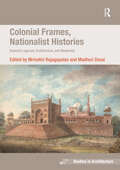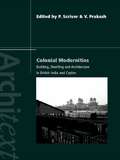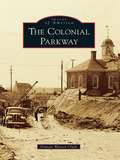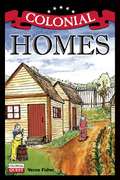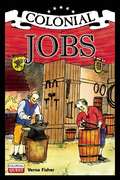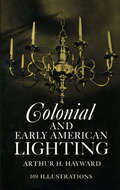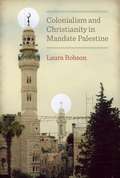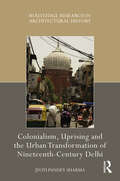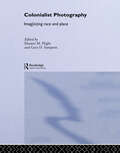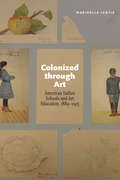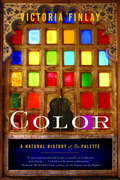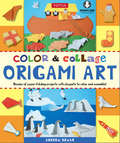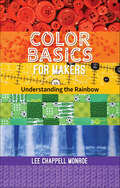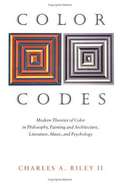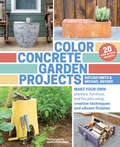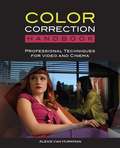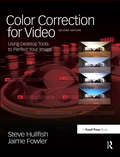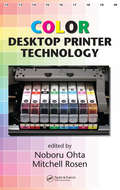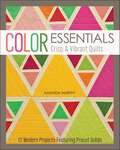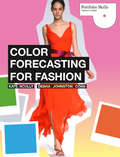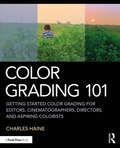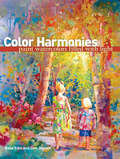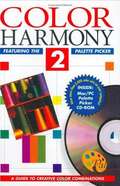- Table View
- List View
Colonial Frames, Nationalist Histories: Imperial Legacies, Architecture, and Modernity (Ashgate Studies in Architecture)
by Mrinalini RajagopalanIn recent years, there has been a growing debate on the various ways that architecture and urbanism have served the triad of colonialism, nationalism and modernity. Some have argued that newly decolonized nations sought to represent their modernity through the spaces and symbols of their new national capitals, while other scholars have stressed that while the forms and processes of architectural modernization have no doubt served as aids to various nation-building projects, it is the specific role of individual agents (such as planners, architects, an emerging twentieth-century bourgeois citizen, or colonial administrators) in this national project that needs attention. However, many such explorations of this subject have so far taken the form of monographs that concentrate on one city, thereby limiting the scope required to address the broader questions at hand. By juxtaposing case studies from various colonial and postcolonial settings from around the world, this edited volume provides a comprehensive and diachronic investigation of the ways in which architecture and urban space mediate the intersections of colonialism, nationalism, and modernity. Examining such spaces as archaeological sites, memorials, new buildings, or historic urban fabric, the book questions certain established dichotomies such as that of the imperial center and the colonized periphery; the colonial past and the postcolonial present; or the isolation of the national or local from the global. Besides offering unique historical perspectives on colonialism, nationalism and modernity, each case-study also reassesses theories regarding memory and monumentalization; the appropriation and deployment of tradition in the service of nationalism; and the institutions of modernity. A common thread throughout the essays in this volume is a focus on new loci of power that emerge either in collision with colonial power structures, or in collaboration with or those that emerge in the wake of decolonization. While the authors recognize the presence of a larger structure of colonial hegemony, they also investigate those centers of power that emerge in the interstices of crevices of colonial power. Interdisciplinary and theoretically innovative, this book offers a global perspective on colonial and national landscapes, rewrites the master creator narrative, examines national landscapes as sites of contestation and views the globalization of processes such as archaeology beyond the boundaries of the national.
Colonial Modernities: Building, Dwelling and Architecture in British India and Ceylon (Architext)
by Vikramaditya Prakash Peter ScriverA carefully crafted selection of essays from international experts, this book explores the effect of colonial architecture and space on the societies involved – both the colonizer and the colonized. Focusing on British India and Ceylon, the essays explore the discursive tensions between the various different scales and dimensions of such 'empire-building' practices and constructions. Providing a thorough exploration of these tensions, Colonial Modernities challenges the traditional literature on the architecture and infrastructure of the former European empires, not least that of the British Indian 'Raj'. Illustrated with seventy-five halftone images, it is a fascinating and thoroughly grounded exposition of the societal impact of colonial architecture and engineering.
Colonial Parkway, The (Images of America)
by Frances Watson ClarkThe Colonial Parkway is a living timeline to the critical beginnings of our nation. Connecting a historic triangle of cities, the parkway winds along the James River overlooking Jamestown Island, where the first permanent English colony was established; through Williamsburg, the Colonial seat of government for the new country; and arrives in Yorktown, where the fledgling nation won independence from the British at the end of the Revolutionary War. The vision of the early directors of the U.S. National Park Service became the foundation for getting the approval to construct a road that would allow visitors to move from one historic place to the next without the disruptions of the modern world. Construction began in the early 1930s, and the final phase was finished in 1957 for the 350th anniversary of the founding of Jamestown. While the parkway is a marvel in engineering, the area it covers also serves as a recreational locale for biking, fishing, and hiking.
Colonial Quest: Colonial Homes
by Verna FisherTaking young readers on a journey back in time, this dynamic new series showcases various aspects of colonial life, from people and clothing to homes and food. Each book contains creative illustrations, interesting facts, highlighted vocabulary words, end-of-book challenges, and sidebars that help children understand the differences between modern and colonial life and inspire them to imagine what it would have been like to grow up in colonial America. The volumes in this series focus on the colonists but also include relevant information about Native Americans, offering a variety of perspectives on life in the colonies.
Colonial Quest: Colonial Jobs
by Verna FisherTaking young readers on a journey back in time, this dynamic new series showcases various aspects of colonial life, from people and clothing to homes and food. Each book contains creative illustrations, interesting facts, highlighted vocabulary words, end-of-book challenges, and sidebars that help children understand the differences between modern and colonial life and inspire them to imagine what it would have been like to grow up in colonial America. The volumes in this series focus on the colonists but also include relevant information about Native Americans, offering a variety of perspectives on life in the colonies. Discussing the various products made by colonists--from flour and iron horseshoes to wooden buckets and furniture--this engaging guidebook teaches young readers about the different craftsmen of the era, including blacksmiths, coppers, and millers. Additional attention is also paid to the goods produced by Native Americans, including leather moccasins and woven baskets, and how these goods were exchanged in a barter economy.
Colonial and Early American Lighting
by Arthur H. HaywardBeginning with the rushlight holders used by the earliest settlers and ranging up to the elaborate chandeliers of the Federal period, this book is a unique coverage of the fascinating story of lamps and other lighting devices in America.The selection of lighting devices from the American Colonies begins with the "Betty" lamps which were similar in function and design to the oil, wax, and fat-burning lamps of antiquity. Rounding out the material on early attempts at illumination are variations on the open wick lamp designs executed in iron, tin, pewter, and brass, together with double iron "Betty" lamps, iron trammel candle holders, wrought iron candle stands, candle molds, reflectors, and other styles. Succeeding chapters range over candelabra lamps, ship lamps, whale oil lamps, wall sconces, bull's eye reading lamps, pierced tin lanterns, candle lanterns, bull's eye reading lanterns, hall lanterns, Sandwich glass candlesticks, lamps of unusual design, glass table and spark lamps, single and double burner mantle lamps, astral lamps, Luster lamps, Bennington ware, and chandeliers made of wood, iron, pewter, brass, bronze, silver, and crystal. Although the main emphasis is on the Colonial era, work up to the 1880's is considered. Each chapter contains information on Colonial life, customs, and habits, photographs of rare lamps and their locations, hints on collecting, and much other information not available elsewhere.This volume, containing what is probably the largest selection of antique lamps ever illustrated together before, fills a long-felt need on the part of antique collectors, designers, historians, and Americana enthusiasts for a thorough-going survey of lighting in Colonial America.
Colonialism and Christianity in Mandate Palestine
by Laura RobsonDrawing on a rich base of British archival materials, Arabic periodicals, and secondary sources, Colonialism and Christianity in Mandate Palestine brings to light the ways in which the British colonial state in Palestine exacerbated sectarianism. By transforming Muslim, Christian, and Jewish religious identities into legal categories, Laura Robson argues, the British ultimately marginalized Christian communities in Palestine. Robson explores the turning points that developed as a result of such policies, many of which led to permanent changes in the region's political landscapes. Cases include the British refusal to support Arab Christian leadership within Greek-controlled Orthodox churches, attempts to avert involvement from French or Vatican-related groups by sidelining Latin and Eastern Rite Catholics, and interfering with Arab Christians' efforts to cooperate with Muslims in objecting to Zionist expansion. Challenging the widespread but mistaken notion that violent sectarianism was endemic to Palestine, Colonialism and Christianity in Mandate Palestine shows that it was intentionally stoked in the wake of British rule beginning in 1917, with catastrophic effects well into the twenty-first century.
Colonialism, Uprising and the Urban Transformation of Nineteenth-Century Delhi (Routledge Research in Architectural History)
by Jyoti Pandey SharmaNo other city in the Indian subcontinent can lay claim to having so many lives as Delhi. This book examines Delhi in the politically and culturally dynamic nineteenth century which was marked midway by the 1857 uprising against British colonial rule as a watershed event. Following British occupation, Delhi became a receptacle for encounters between the centuries-old Mughal traditions and the incoming colonial ideal, producing a traditionalism-modernity binary. Employing the built environment lens, the book traces the architectural trajectory of Delhi as it transitioned from the seventeenth-century Mughal Badshahi Shahar (imperial city) first into a culturally hybrid Dilli-Delhi combine of the pre-uprising era and thereafter into a modern British city following the uprising. This transition is presented via four constructs that draw on the traditionalism-modernity binary of Mughal and British Delhi and include Marhoom Dilli (Dead Delhi); Picturesque Delhi; Baaghi Dilli (Insurgent Delhi) and Tamed Delhi. The book goes beyond the nineteenth century to examine the vestiges of Delhi’s four nineteenth-century lives in the present while making a case for their acknowledgement as a cultural asset that can propel the city’s urban development agenda. By bringing together the city’s past and its present as well as addressing its future, the book can count among its readers not just scholars but also those interested in cities and their evolving landscapes.
Colonialist Photography: Imag(in)ing Race and Place
by Eleanor M. Hight Gary D. SampsonColonialist Photography is an absorbing collection of essays and photographs exploring the relationship between photography and European and American colonialism. The book is packed with well over a hundred captivating images, ranging from the first experiments with photography as a documentary medium up to the decolonization of many regions after World War II. Reinforcing a broad range of Western assumptions and prejudices, Eleanor M. Hight and Gary D. Sampson argue that such images often assisted in the construction of a colonial culture.
Colonized through Art: American Indian Schools and Art Education, 1889-1915
by Marinella LentisColonized through Art explores how the federal government used art education for American Indian children as an instrument for the “colonization of consciousness,” hoping to instill the values and ideals of Western society while simultaneously maintaining a political, social, economic, and racial hierarchy. Focusing on the Albuquerque Indian School in New Mexico, the Sherman Institute in Riverside, California, and the world’s fairs and local community exhibitions, Marinella Lentis examines how the U.S. government’s solution to the “Indian problem” at the end of the nineteenth century emphasized education and assimilation. Educational theories at the time viewed art as the foundation of morality and as a way to promote virtues and personal improvement. These theories made the subject of art a natural tool for policy makers and educators to use in achieving their assimilationist goals of turning student “savages” into civilized men and women. Despite such educational regimes for students, however, indigenous ideas about art oftentimes emerged “from below,” particularly from well-known art teachers such as Arizona Swayney and Angel DeCora.Colonized through Art explores how American Indian schools taught children to abandon their cultural heritage and produce artificially “native” crafts that were exhibited at local and international fairs. The purchase of these crafts by the general public turned students’ work into commodities and schools into factories.
Color
by Victoria FinlayIn this vivid and captivating journey through the colors of an artist's palette, Victoria Finlay takes us on an enthralling adventure around the world and through the ages, illuminating how the colors we choose to value have determined the history of culture itself.How did the most precious color blue travel all the way from remote lapis mines in Afghanistan to Michelangelo's brush? What is the connection between brown paint and ancient Egyptian mummies? Why did Robin Hood wear Lincoln green? In Color, Finlay explores the physical materials that color our world, such as precious minerals and insect blood, as well as the social and political meanings that color has carried through time.Roman emperors used to wear togas dyed with a purple color that was made from an odorous Lebanese shellfish-which probably meant their scent preceded them. In the eighteenth century, black dye was called logwood and grew along the Spanish Main. Some of the first indigo plantations were started in America, amazingly enough, by a seventeen-year-old girl named Eliza. And the popular van Gogh painting White Roses at Washington's National Gallery had to be renamed after a researcher discovered that the flowers were originally done in a pink paint that had faded nearly a century ago. Color is full of extraordinary people, events, and anecdotes-painted all the more dazzling by Finlay's engaging style.Embark upon a thrilling adventure with this intrepid journalist as she travels on a donkey along ancient silk trade routes; with the Phoenicians sailing the Mediterranean in search of a special purple shell that garners wealth, sustenance, and prestige; with modern Chilean farmers breeding and bleeding insects for their viscous red blood. The colors that craft our world have never looked so bright.From the Hardcover edition.
Color & Collage Origami Art
by Andrew DewarMake lively scenes out of paper models with this fun children's origami ebook.Kids love to make crafts. Whether it's scribbling on a page, putting stickers all over everything or cutting out crazy shapes, kids take supreme pleasure in being crafty.The Color & Collage Origami Art is a unique new origami paper craft product that will teach children to fold, assemble, compose, color and display large collages. They'll have fun folding individual origami models for stand-alone play and as an added bonus being able to arrange these pieces on the included collage backgrounds. All of the folds are designed to be origami-for-kids projects and are a great way to learn origami. None of the projects require paint or tools so just grab some origami paper and start folding right away!The ebook contains: Step-by-step instruction Easy-to-follow diagrams 35 fun origami projectsRegardless of skill level, kids will be folding like a pro right out of the gate with The Color & Collage Origami ebook.Origami Projects include: Gingerbread House Starry Sky Playhouse Penguin Picnic Christmas TreeNoah's Ark
Color + Design: Transforming Interior Space
by Ronald ReedIn this second edition of Color + Design: Transforming Interior Space, Ron Reed instructs interior designers how to effectively use color in conjunction with key design principles such as balance, rhythm, emphasis, proportion, scale, unity, harmony, and variety. This new edition expands upon the author's innovative approach with an updated art program featuring increased coverage of current commercial and residential environments; updated insights into how people perceive color, including new content about different cultures and ageing populations; and updated and expanded pedagogical features and exercises.
Color Basics for Makers: Understanding the Rainbow
by Lee Chappell MonroeInteractive guide to understand and apply the fundamentals of color! Confidence is key when it comes to color! Join Lee Monroe as she shares the tips and tricks from her most popular art class useful for every crafter at any skill level. Using fine art and design knowledge, she shares an overview of color theory that demystifies the concepts. Learn the color fundamentals and get a clear understanding of how the saturation of the color pigment changes as white, black, or grey are added. Readers then explore what makes a successful palette and how different color combinations affect the mood of a finished piece. Try out the concepts in any medium with hands-on exercises and practical beginner-friendly projects. Elevate your art with a true understanding of color theory! Learn to select and use color with confidence with hands-on exercises that demystifies choosing and using colors For every crafter and artist! Work with fabrics, paint, embroidery, printmaking, colored pencils, and more Gain insight on how to combine colors, and find practical applications for identifying colors, values, and purity
Color Codes: Modern Theories of Color in Philosophy, Painting and Architecture, Literature, Music and Psychology
by Charles A. Riley IIScholarly Essays on the symbolic use of color in the arts and literature.
Color Concrete Garden Projects: Make Your Own Planters, Furniture, and Fire Pits Using Creative Techniques and Vibrant Finishes
by Michael Snyder Nathan Smith Charles ColemanA Library Journal Best Crafts & DIY Book of 2015 Incorporating concrete design into a home garden can now be easily achieved by any do-it-yourself enthusiast! Concrete furniture and containers add style and personality to outdoor spaces, and the addition of color makes these objects even more eye-catching. These trendy pieces can cost thousands of dollars at garden centers and furniture stores, but they can also be made affordably at home. In this hands-on guide, concrete artisans Nathan Smith and Michael Snyder offer basic information on how to mix concrete and add color using dyes, paints, and inlaid materials. The twenty step-by-step projects include small items, like a candle holder with an old-world feel and a simple stacked-ring planter, and larger pieces, like an elegant bike rack and a beautiful fire pit that is the perfect gathering place for friends and family.
Color Correction Handbook: Professional Techniques for Video and Cinema
by Alexis Van HurkmanThis is a comprehensive guide to color correction for film and video professionals covering every major color-correction software and hardware system. You will learn to apply the methods that all of the color correction applications use, how to problem-solve and trouble-shoot, how to maximize the effectiveness of each tool that's available, and you will discover how to creatively combine techniques and tools to accomplish the types of stylizations that colorists are often called upon to create.
Color Correction for Video: Using Desktop Tools to Perfect Your Image (Dv Expert Ser.)
by Steve Hullfish Jaime FowlerUse color to improve your storytelling, deliver critical emotional cues, and add impact to you videos. This book shows you how to analyze color correction problems and solve them- whatever NLE or plugin you use. Experienced editors and colorists in their own right, the authors also include the wisdom of top colorists, directors of photography, and color scientists to deliver this insightful and authoritative presentation of the theory and practice of color correction.The book provides technical insight into how to effectively color correct your video, also delving into how color can impact storytelling and deliver critical emotional cues. The new edition also includes 2 new "Quickstart Tutorials", a new chapter on how color impacts storytelling, information on the impact HD has had on the correcting process, and updated application specifications. The companion DVD features new and more robust tutorial media.
Color Desktop Printer Technology
by Noboru Ohta Mitchell RosenPrinting traces its roots back for centuries, and the invention of moveable type changed the world. However, until the advent of the computer, printing remained a costly and time-consuming operation. From the first humble dot matrix to modern inkjet, laser, and dye sublimation printers, desktop printing has brought low-cost, high quality printing out of the large presses and into the home and office. Color Desktop Printer Technology provides an overview of the current state of the technology, examining both current and emerging applications.With expert contributors from leading companies and universities in the US and Japan, this book examines the color desktop printer from every angle. It begins with an introduction to the basic principles of color printing and the concepts of document and image quality. An overview of the historical background, current trends, and future directions places the technology in its business and market context. The book then devotes four chapters to the major platform: inkjet, laser printer, thermal transfer, and film recording. The last two chapters focus on color management and the quickly developing spectral printing technology.Laying a foundation for continued development and innovation in this ubiquitous field, Color Desktop Printer Technology is fundamental enough to be enjoyed by interested laypersons, yet detailed enough to satisfy the practicing engineer.
Color Drawing
by Michael E. DoyleThe Third Edition of Michael Doyle's classic Color Drawing remains the ultimate up-to-date resource for professionals and students who need to develop and communicate design ideas with clear, attractive, impressive color drawings.Update with over 100 pages, this Third Edition contains an entirely new section focused on state-of-the-art digital techniques to greatly enhance the sophistication of presentation drawings, and offers new and innovative ideas for the reproduction and distribution of finished drawings. Color Drawing, Third Edition Features:* A complete body of illustrated instructions demonstrating drawing development from initial concept through final presentation* Finely honed explanations of each technique and process* Faster and easier ways to create design drawings* Over 100 new pages demonstrating methods for combining hand-drawn and computer-generated drawing techniquesStep-by-step, easy-to-follow images will lead you through digital techniques to quickly and easily enhance your presentation drawings.
Color Essentials: Crisp and Vibrant Quilts
by Amanda MurphyThe essential reference on quilting with color Free yourself from preconceived notions about color and get ready to push the creative envelope! This must-have book inspires you to experiment with solids to gain a deep understanding of how color functions. Perfect for both the adventurous beginner and skilled intermediate quilter, the 12 modern quilt projects show you how to create fresh combinations, vibrancy, and movement using different hues. To make the projects accessible, affordable, and stunning, author Amanda Murphy developed a pre-cut package of Robert Kaufman Fabrics that can be used in conjunction with this book. • Perfect go-to guide for quilters of any skill level • Create 12 quilts (9 pieced quilts, pillow, placemat, and table runner) with a dynamic style • Designs use pre-cut strips, squares, roll ups, and fat-quarter bundles
Color Forecasting for Fashion
by Kate ScullyColor is a powerful selling tool. It is the first thing to catch the consumer's eye in the shop window. Get the color choice wrong and an entire range can stay on the racks. So, how do colors arrive on the runway or the sales floor and why do different companies all seem to choose similar colors each season? The answer lies in the work of the huge color forecasting industry. Color Forecasting for Fashion breaks down the forecasting process—from how to put together a color palette to color theory and the way that colors behave—and helps you to build the combination of research and intuitive skills that a successful designer or forecaster needs.
Color Grading 101: Getting Started Color Grading for Editors, Cinematographers, Directors, and Aspiring Colorists
by Charles HaineWritten both for students and working professionals, this book walks readers step-by-step through the foundations of color grading for projects of any size, from music videos and commercials to full-length features. In this clear, practical, and software-agnostic guide, author Charles Haine introduces readers to the technical and artistic side of color grading and color correction. Color Grading 101 balances technical chapters like color-matching, mastering, and compression with artistic chapters like contrast/affinity, aesthetic trends, and building a color plan. The book also includes more business-focused chapters detailing best practices and expert advice on working with clients, managing a team, working with VFX, and building a business. An accompanying eResource offers downloadable footage and project files to help readers work through the exercises and examples in the book. This book serves as a perfect introduction for aspiring colorists as well as editors, cinematographers, and directors looking to familiarize themselves with the color grading process.
Color Harmonies: Paint Watercolors Filled with Light
by Rose Edin Dee JepsenSimple secrets for colors that sing Don't settle for colors that just sit there. Inspired by the work of the great Impressionists, Color Harmonies shows you how to use analogous colors (colors next to each other on the color wheel) and their complements to achieve lively, glowing effects. By keeping palette-mixing to a minimum, placing pure color notes side by side, and applying other simple but powerful color tricks, you'll create sparkling passages of color that attract your viewer's eye, engage the imagination, and make your paintings shine. 5 demonstrations illustrate the step-by-step creation of stunning light-filled paintings. Includes expert instruction on drawing and composition, techniques for adding texture and interest, making the most of light and shadow, and more. Richly illustrated with gorgeous landscape, flower and figure paintings. Brimming with 30 years' worth of instruction by a veteran workshop teacher, Color Harmonies offers a strong foundation for artists just starting out in watercolor, as well as groundbreaking advice for advanced artists in search of more effective and personal approaches to color and light.
Color Harmony 2
by Bride M. WhelanDescribes the emotional impact of color and the use of color in fashion and design.
